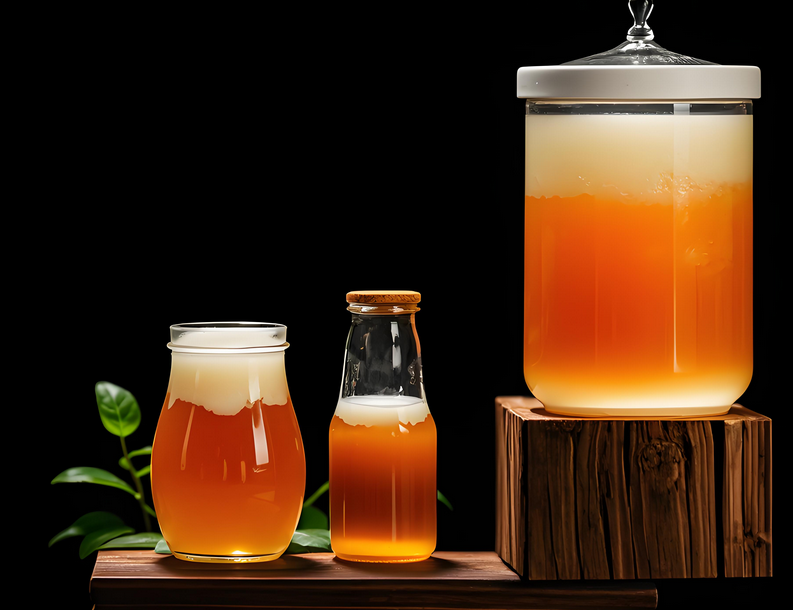How to Make Kombucha
Introduction to Kombucha Brewing
Kombucha, a fermented tea beverage celebrated for its tangy flavor and probiotic benefits, has surged in popularity among health enthusiasts worldwide. Learning how to make kombucha at home not only saves money but also allows customization of flavors and fermentation intensity. This guide will walk you through a kombucha recipe rooted in traditional methods while incorporating modern brewing insights. Whether you’re a novice or an experienced fermenter, mastering how to brew kombucha empowers you to create a beverage tailored to your palate and wellness goals
Essential Ingredients & Tools for Your Kombucha Recipe
Before diving into how to make kombucha, gather these core components:
- Tea Base:
- Use 8–10g of high-quality loose-leaf black, green, or oolong tea per 1L water. Avoid blends with oils or artificial flavors (e.g., Earl Grey)1.
- Pro Tip: Black tea provides robust tannins for SCOBY health, while green tea yields a lighter, floral profile.
- Sugar:
- White cane sugar (1 cup per 1 gallon) is ideal—it’s easily digestible by the SCOBY. Avoid honey or alternatives in primary fermentation2.
- SCOBY (Symbiotic Culture of Bacteria and Yeast):
- Acquire a healthy, cream-colored culture from a trusted source or grow one using raw, unflavored store-bought kombucha4.
- Starter Liquid:
- Use 2 cups of mature kombucha from a previous batch or unpasteurized commercial kombucha to acidify the brew1.
- Equipment:
- 1-gallon glass jar, breathable cloth cover, pH strips (target: 3.5–4.5), and swing-top bottles for carbonation2

Step-by-Step Guide: How to Brew Kombucha
1. Brewing the Sweet Tea Base
- Boil 1L of filtered water and dissolve 1 cup of sugar.
- Steep tea leaves for 7–10 minutes (black tea) or 5–7 minutes (green tea) to avoid bitterness1.
- Cool the tea to 20–30°C (68–86°F)—critical to prevent SCOBY damage2.
2. Initiating Primary Fermentation
- Combine cooled tea, starter liquid, and SCOBY in the glass jar.
- Cover with a tight-weave cloth secured by a rubber band.
- Ferment at 20–27°C (68–80°F) for 7–14 days. Taste daily from day 7 until balanced acidity is achieved12.
Key Observation: A new SCOBY layer forms atop the liquid within 3–5 days—a sign of active fermentation
3. Bottling & Secondary Fermentation (Carbonation)
- Reserve 2 cups of kombucha as starter liquid for your next batch.
- Transfer the remaining liquid to bottles, adding flavorings like ginger, berries, or citrus zest.
- Seal bottles and carbonate at room temperature for 1–3 days. Burp bottles daily to release excess CO22.
- Refrigerate to halt fermentation and enjoy within a month.
Advanced Techniques for Perfecting Your Kombucha Recipe
Elevate your kombucha brewing with these pro strategies:
- Flavor Layering:
Combine fruits (pineapple, mango) with herbs (basil, mint) for complexity.
Example: Blueberry-ginger kombucha adds antioxidant-rich depth1.
Alcohol Control:
Limit secondary fermentation to 1–2 days if avoiding higher alcohol content (>0.5%).
SCOBY Maintenance:
Store extra cultures in a “SCOBY hotel”—a jar of sweet tea and starter liquid refreshed monthly4.
Troubleshooting:
Mold: Discard the batch if fuzzy spots appear. Prevent by maintaining pH <4.5 and sterilizing equipment1.
Weak Carbonation: Increase sugar in secondary fermentation or extend bottling time2.
The Science Behind Kombucha Fermentation
Understanding the microbial symphony in your kombucha recipe enhances brewing precision:
Yeast: Convert sucrose into glucose and ethanol (Saccharomyces species).
Acetic Acid Bacteria: Oxidize ethanol into acetic acid, creating tartness and lowering pH (Acetobacter).
Lactic Acid Bacteria: Contribute subtle sourness and probiotic diversity (Lactobacillus)3.
This synergy produces a beverage rich in organic acids (gluconic, glucuronic) linked to detoxification and gut health.
Creative Variations: Reinventing the Classic Kombucha Recipe
Experiment with these trends inspired by global fermenters:
Herbal Infusions:
Hibiscus or chamomile tea bases for caffeine-free options.
Spiced Brews:
Turmeric, cinnamon, or cardamom add warmth and anti-inflammatory benefits.
Kombucha “Cocktails”:
Mix with sparkling water and lime for a probiotic mocktail.
Savory Blends:
Tomato juice and celery salt create a gut-healthy “Kombucha Mary”

Conclusion: Mastering the Art of Homemade Kombucha
Learning how to make kombucha transforms simple ingredients into a living elixir. By refining your kombucha recipe with quality ingredients, precise fermentation control, and creative flair, you’ll craft a beverage that delights the senses and nourishes the body. Start your brewing journey today and join the global community reviving this ancient probiotic tradition
If you want to know more about Chinese tea, please visit our homepage, Tanbiwencha



